Abstract
1. Nitric oxide (NO) suppresses platelet aggregation and plasminogen activator inhibitor (PAI) release from platelets, playing physiological and/or pathological roles in the haemostatic system. We investigated the effect of NG-nitro-L-arginine methyl ester (L-NAME), an NO synthase inhibitor, on the disseminated intravascular coagulation (DIC)-like phenomena in rats under environmental stress, induced by prolonged fluctuation in air temperature, known as SART (specific alternation of rhythm in temperature) stress. 2. Exposure of rats to SART stress for 7 days caused mild DIC-like symptoms such as thrombocytopenia, hypofibrinogenemia, decreased factor VIII: coagulant activity and shortened euglobulin clot lysis time (ECLT). The enhanced fibrinolysis was accompanied by a marked decrease in the activity of plasma PAI. 3. L-NAME, but not its D-enantiomer, when administered orally at 0.3-10 mg kg-1, twice a day for 7-day exposure to stress, inhibited the stress-induced decrease in fibrinogen levels in a dose-dependent manner, whereas it failed to alter platelet count, factor VIII:coagulant activity and plasma protein levels in stressed rats. All these parameters in unstressed rats were resistant to L-NAME at 10 mg kg-1. 4. Repeated treatment with 10 mg kg-1 of L-NAME blocked the shortening of ECLT and the decrease in PAI activity following stress exposure, although it was without effect in unstressed rats. 5. The inhibitory effects of L-NAME at 10 mg kg-1 on the stress-induced alterations in fibrinogen levels and in ECLT were significantly reduced by coadministered L-arginine at 1000 mg kg-1. 6. These findings demonstrate that repeated administration of L-NAME attenuates the enhanced fibrinolysis, without aggravating thrombocytopenia, in SART-stressed rats. Endogenous NO appears to contribute to the stress-induced development of fibrinolysis by suppressing, plasma PAI activity, most probably as a result of inhibition of the PAI release from platelets.
Full text
PDF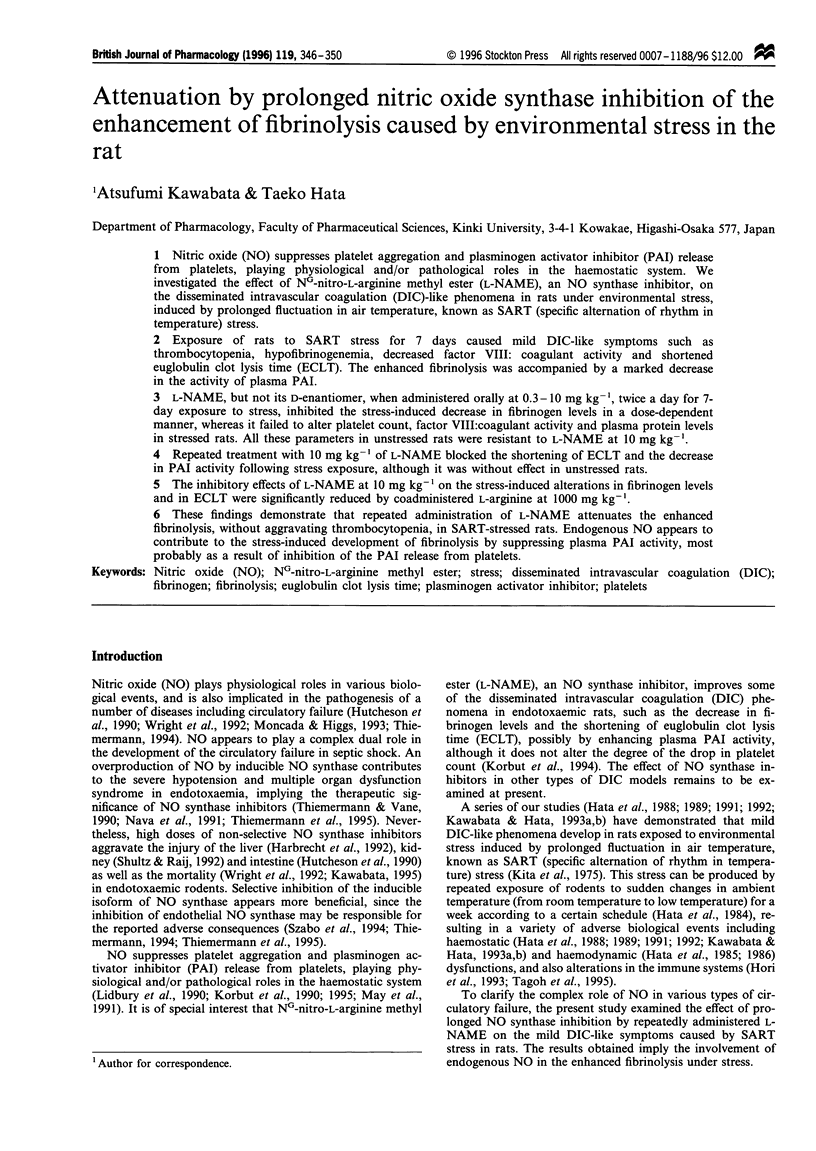
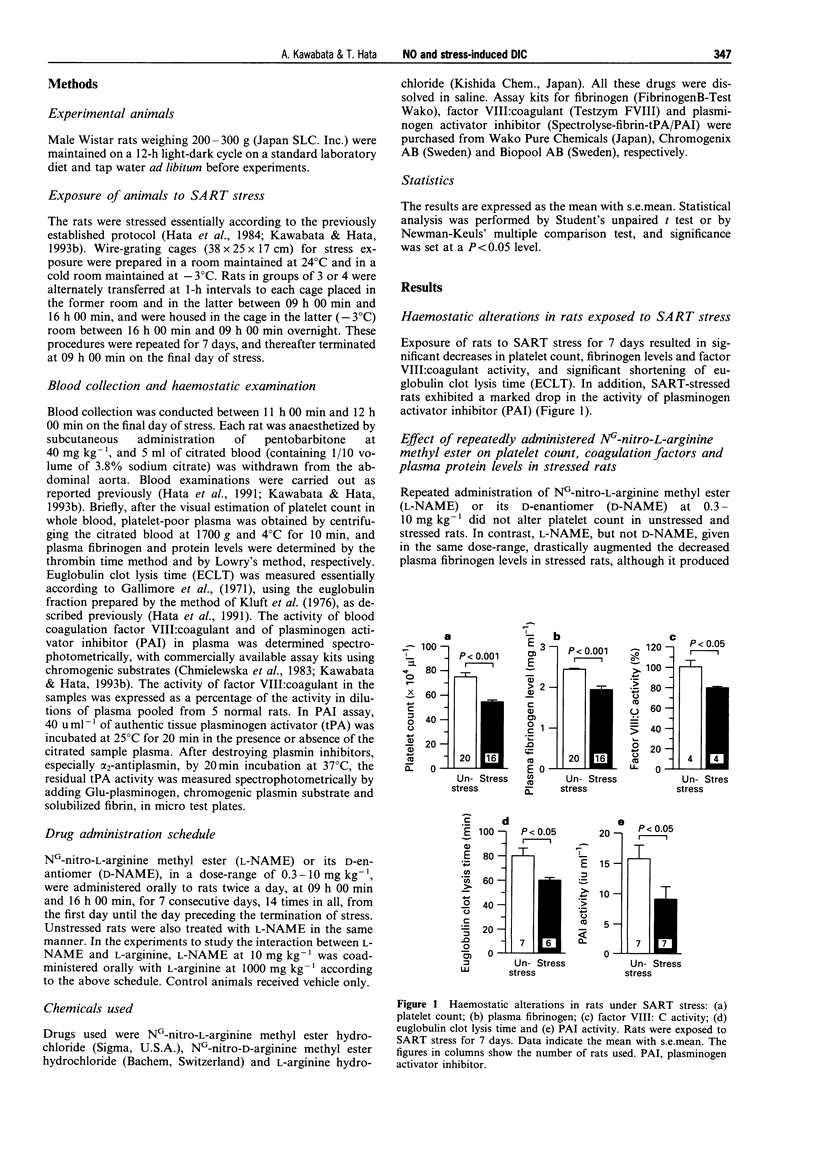
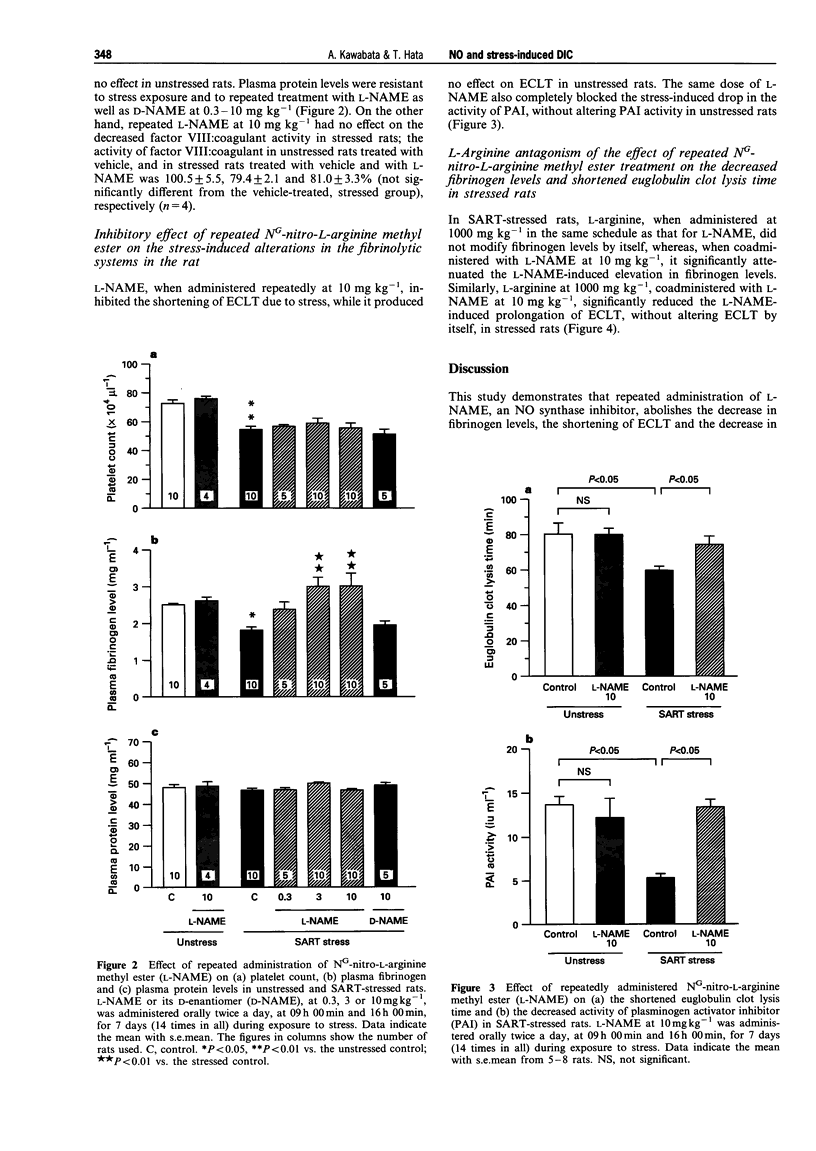
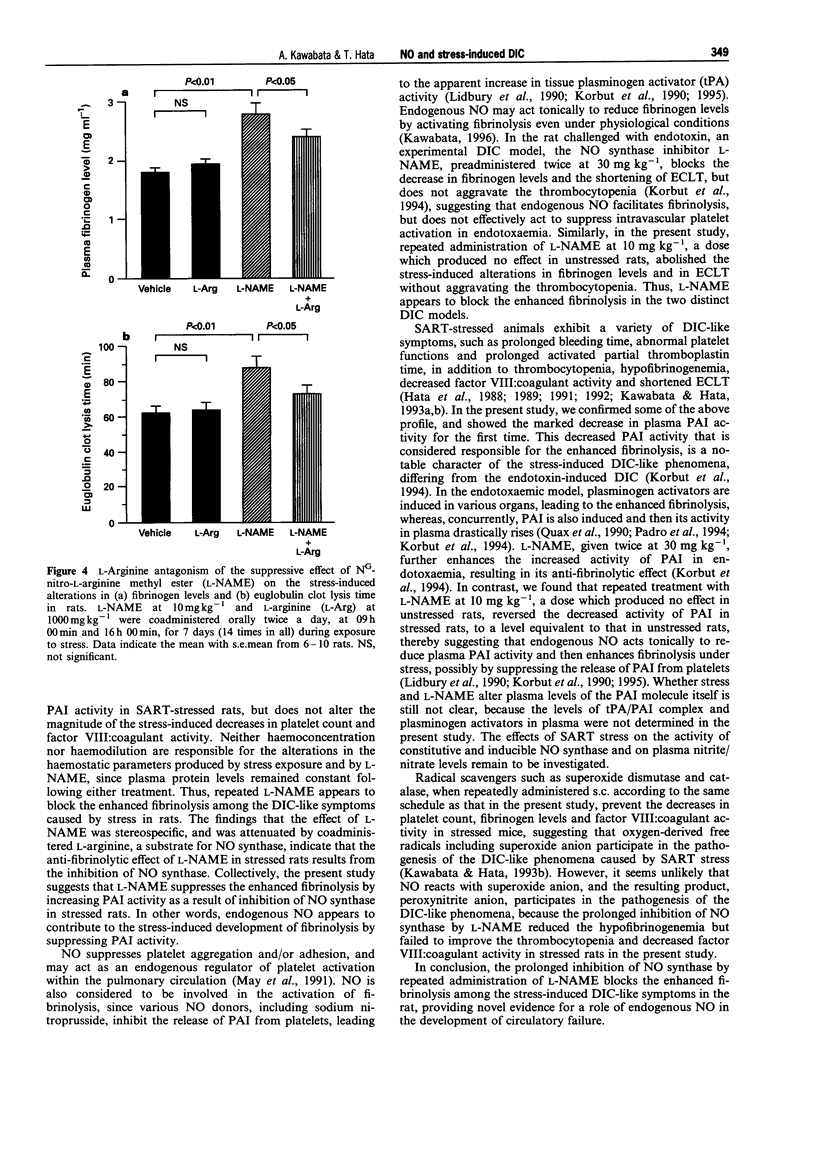
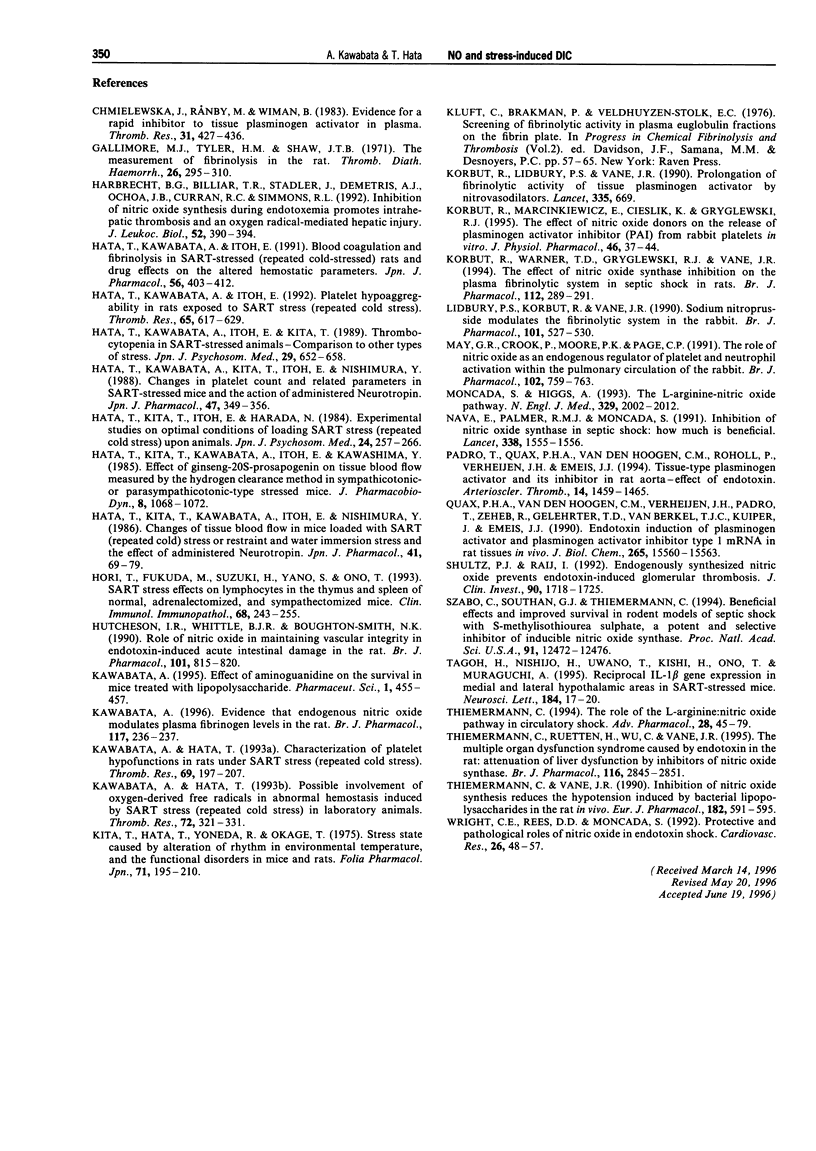
Selected References
These references are in PubMed. This may not be the complete list of references from this article.
- Gallimore M. J., Tyler H. M., Shaw J. T. The measurement of fibrinolysis in the rat. Thromb Diath Haemorrh. 1971 Oct 31;26(2):295–310. [PubMed] [Google Scholar]
- Harbrecht B. G., Billiar T. R., Stadler J., Demetris A. J., Ochoa J., Curran R. D., Simmons R. L. Inhibition of nitric oxide synthesis during endotoxemia promotes intrahepatic thrombosis and an oxygen radical-mediated hepatic injury. J Leukoc Biol. 1992 Oct;52(4):390–394. doi: 10.1002/jlb.52.4.390. [DOI] [PubMed] [Google Scholar]
- Hata T., Kawabata A., Itoh E. Blood coagulation and fibrinolysis in SART-stressed (repeated cold-stressed) rats and drug effects on the altered hemostatic parameters. Jpn J Pharmacol. 1991 Aug;56(4):403–412. doi: 10.1254/jjp.56.403. [DOI] [PubMed] [Google Scholar]
- Hata T., Kawabata A., Itoh E. Platelet hypoaggregability in rats exposed to SART stress (repeated cold stress). Thromb Res. 1992 Mar 1;65(4-5):617–629. doi: 10.1016/0049-3848(92)90211-r. [DOI] [PubMed] [Google Scholar]
- Hata T., Kawabata A., Kita T., Itoh E., Nishimura Y. Changes in platelet count and related parameters in SART-stressed mice and the action of administered neurotropin. Jpn J Pharmacol. 1988 Aug;47(4):349–356. doi: 10.1254/jjp.47.349. [DOI] [PubMed] [Google Scholar]
- Hata T., Kita T., Kawabata A., Itoh E., Kawashima Y. Effect of ginseng-20S-prosapogenin on tissue blood flow measured by the hydrogen clearance method in sympathicotonic- or parasympathicotonic-type stressed mice. J Pharmacobiodyn. 1985 Dec;8(12):1068–1072. doi: 10.1248/bpb1978.8.1068. [DOI] [PubMed] [Google Scholar]
- Hata T., Kita T., Kawabata A., Itoh E., Nishimura Y. Changes of tissue blood flow in mice loaded with SART (repeated cold) stress or restraint and water immersion stress and the effect of administered neurotropin. Jpn J Pharmacol. 1986 May;41(1):69–79. doi: 10.1254/jjp.41.69. [DOI] [PubMed] [Google Scholar]
- Hori T., Fukuda M., Suzuki H., Yano S., Ono T. SART stress effects on lymphocytes in the thymus and spleen of normal, adrenalectomized, and sympathectomized mice. Clin Immunol Immunopathol. 1993 Sep;68(3):243–245. doi: 10.1006/clin.1993.1125. [DOI] [PubMed] [Google Scholar]
- Hutcheson I. R., Whittle B. J., Boughton-Smith N. K. Role of nitric oxide in maintaining vascular integrity in endotoxin-induced acute intestinal damage in the rat. Br J Pharmacol. 1990 Dec;101(4):815–820. doi: 10.1111/j.1476-5381.1990.tb14163.x. [DOI] [PMC free article] [PubMed] [Google Scholar]
- Kawabata A. Evidence that endogenous nitric oxide modulates plasma fibrinogen levels in the rat. Br J Pharmacol. 1996 Jan;117(2):236–237. doi: 10.1111/j.1476-5381.1996.tb15181.x. [DOI] [PMC free article] [PubMed] [Google Scholar]
- Kawabata A., Hata T. Characterization of platelet hypofunctions in rats under SART stress (repeated cold stress). Thromb Res. 1993 Jan 15;69(2):197–207. doi: 10.1016/0049-3848(93)90045-p. [DOI] [PubMed] [Google Scholar]
- Kawabata A., Hata T. Possible involvement of oxygen-derived free radicals in abnormal hemostasis induced by SART stress (repeated cold stress) in laboratory animals. Thromb Res. 1993 Nov 15;72(4):321–331. doi: 10.1016/0049-3848(93)90141-a. [DOI] [PubMed] [Google Scholar]
- Kita T., Hata T., Yoneda R., Okage T. [Stress state caused by alteration of rhythms in environmental temperature, and the functional changes in mice and rats]. Nihon Yakurigaku Zasshi. 1975 Mar;71(2):195–210. doi: 10.1254/fpj.71.195. [DOI] [PubMed] [Google Scholar]
- Korbut R., Lidbury P. S., Vane J. R. Prolongation of fibrinolytic activity of tissue plasminogen activator by nitrovasodilators. Lancet. 1990 Mar 17;335(8690):669–669. doi: 10.1016/0140-6736(90)90462-e. [DOI] [PubMed] [Google Scholar]
- Korbut R., Marcinkiewicz E., Cieślik K., Gryglewski R. J. The effect of nitric oxide donors on the release of plasminogen activator inhibitor (PAI) from rabbit platelets in vitro. J Physiol Pharmacol. 1995 Mar;46(1):37–44. [PubMed] [Google Scholar]
- Korbut R., Warner T. D., Gryglewski R. J., Vane J. R. The effect of nitric oxide synthase inhibition on the plasma fibrinolytic system in septic shock in rats. Br J Pharmacol. 1994 May;112(1):289–291. doi: 10.1111/j.1476-5381.1994.tb13066.x. [DOI] [PMC free article] [PubMed] [Google Scholar]
- Lidbury P. S., Korbut R., Vane J. R. Sodium nitroprusside modulates the fibrinolytic system in the rabbit. Br J Pharmacol. 1990 Nov;101(3):527–530. doi: 10.1111/j.1476-5381.1990.tb14115.x. [DOI] [PMC free article] [PubMed] [Google Scholar]
- May G. R., Crook P., Moore P. K., Page C. P. The role of nitric oxide as an endogenous regulator of platelet and neutrophil activation within the pulmonary circulation of the rabbit. Br J Pharmacol. 1991 Mar;102(3):759–763. doi: 10.1111/j.1476-5381.1991.tb12246.x. [DOI] [PMC free article] [PubMed] [Google Scholar]
- Moncada S., Higgs A. The L-arginine-nitric oxide pathway. N Engl J Med. 1993 Dec 30;329(27):2002–2012. doi: 10.1056/NEJM199312303292706. [DOI] [PubMed] [Google Scholar]
- Nava E., Palmer R. M., Moncada S. Inhibition of nitric oxide synthesis in septic shock: how much is beneficial? Lancet. 1991 Dec 21;338(8782-8783):1555–1557. doi: 10.1016/0140-6736(91)92375-c. [DOI] [PubMed] [Google Scholar]
- Padró T., Quax P. H., van den Hoogen C. M., Roholl P., Verheijen J. H., Emeis J. J. Tissue-type plasminogen activator and its inhibitor in rat aorta. Effect of endotoxin. Arterioscler Thromb. 1994 Sep;14(9):1459–1465. doi: 10.1161/01.atv.14.9.1459. [DOI] [PubMed] [Google Scholar]
- Quax P. H., van den Hoogen C. M., Verheijen J. H., Padro T., Zeheb R., Gelehrter T. D., van Berkel T. J., Kuiper J., Emeis J. J. Endotoxin induction of plasminogen activator and plasminogen activator inhibitor type 1 mRNA in rat tissues in vivo. J Biol Chem. 1990 Sep 15;265(26):15560–15563. [PubMed] [Google Scholar]
- Shultz P. J., Raij L. Endogenously synthesized nitric oxide prevents endotoxin-induced glomerular thrombosis. J Clin Invest. 1992 Nov;90(5):1718–1725. doi: 10.1172/JCI116045. [DOI] [PMC free article] [PubMed] [Google Scholar]
- Szabó C., Southan G. J., Thiemermann C. Beneficial effects and improved survival in rodent models of septic shock with S-methylisothiourea sulfate, a potent and selective inhibitor of inducible nitric oxide synthase. Proc Natl Acad Sci U S A. 1994 Dec 20;91(26):12472–12476. doi: 10.1073/pnas.91.26.12472. [DOI] [PMC free article] [PubMed] [Google Scholar]
- Tagoh H., Nishijo H., Uwano T., Kishi H., Ono T., Muraguchi A. Reciprocal IL-1 beta gene expression in medial and lateral hypothalamic areas in SART-stressed mice. Neurosci Lett. 1995 Jan 16;184(1):17–20. doi: 10.1016/0304-3940(94)11157-e. [DOI] [PubMed] [Google Scholar]
- Thiemermann C., Ruetten H., Wu C. C., Vane J. R. The multiple organ dysfunction syndrome caused by endotoxin in the rat: attenuation of liver dysfunction by inhibitors of nitric oxide synthase. Br J Pharmacol. 1995 Dec;116(7):2845–2851. doi: 10.1111/j.1476-5381.1995.tb15935.x. [DOI] [PMC free article] [PubMed] [Google Scholar]
- Thiemermann C. The role of the L-arginine: nitric oxide pathway in circulatory shock. Adv Pharmacol. 1994;28:45–79. doi: 10.1016/s1054-3589(08)60493-7. [DOI] [PubMed] [Google Scholar]
- Thiemermann C., Vane J. Inhibition of nitric oxide synthesis reduces the hypotension induced by bacterial lipopolysaccharides in the rat in vivo. Eur J Pharmacol. 1990 Jul 17;182(3):591–595. doi: 10.1016/0014-2999(90)90062-b. [DOI] [PubMed] [Google Scholar]
- Wright C. E., Rees D. D., Moncada S. Protective and pathological roles of nitric oxide in endotoxin shock. Cardiovasc Res. 1992 Jan;26(1):48–57. doi: 10.1093/cvr/26.1.48. [DOI] [PubMed] [Google Scholar]


